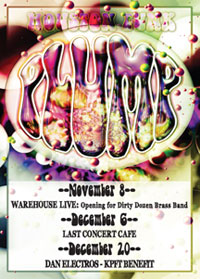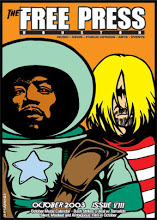SXSW Film 08 wrap
Home entertainment will never replace the experience of going to the movies. Likewise going to the movies will never replace the experience of going to film festivals. At the SXSW Film Festival and Conference, which unrolled in Austin last month, important documentaries played next to stoner midnight flicks. Mainstream studio fare unwound besides obscure indie films themselves seeing light for perhaps the first and only time.
SWSX was recently referred to in a trade publication as the film festival that Slamdance (an unofficial companion to the Sundance FF) hoped to become. The buzz (not including the smoke in the air at the premiere of Harold and Kumar Escape From Guantanamo Bay) was created evenly across eight different categories.
Recounting the 17 films I saw (I counted 112 feature length titles in the program), there are some whose images remain in my mind. Then there are the films I missed yet cannot wait to catch up with, like an Alex Gibney docu on Hunter S. Thompson or a new film from Julian Schnabel called Lou Reed’s Berlin.
Here are some thoughts on films that found me a willing captive, organized by SXSW category. Of the 16 films listed in competition The Lost Coast was the only one I caught. The story takes place overnight during Halloween in San Francisco and the digital lensing accentuates washed out colors – in fact the film looks black and white at times (evidently due to perfectly overcast skies during production). Another entire sequence was shot during a celebration involving thousands of people in the Castro district, a feat logistically impossible with a studio film. A group of friends come to terms with repressed issues of sexuality but more importantly the filmmakers use their actual locations, and how they affect the character’s emotions, to great effect.
In the Emerging Visions category the mocumentary A Necessary Death played it straight for the world premiere. The film works, even though you know it’s a faux documentary, because the chain of events follows a true path. The filmmakers would have us believe they posted an internet ad looking for potential suicides, then interviewed several people before coming up with the most likely candidate. The ending catches you off guard. Will you believe it? Hey, people with degrees were telling me Blair Witch was real.
Six films in the Spotlight Premieres section, out of 35 total, ran the gamut from important documentaries making their world premiere to genre films getting small to wide releases in the next month. 21 (Sony/Columbia) and Stop Loss (Paramount) were received with cheers by their respective festival audiences if only because of attendance from the various stars and directors. Both films tell familiar stories with some of today’s hottest actors. In other words Sony’s release of 21 has a lot to do with them positioning Jim Sturgess as their new It Boy. Sturgess was great in Across the Universe and miscast in The Other Boleyn Girl. 21 never registers strong enough on the richter scale of coolness to give it raves, but the first half where they explain the technique of card counting at blackjack was fascinating. Stop Loss saw a heavy push with plenty of media placement (MTV Films) and appearance by writer-director Kimberly Peirce in both Austin and Houston.
Peirce noted during a chat with Free Press Houston that it had taken over seven years to get this film in theaters since her debut Boys Don’t Cry. After that film she’d tried to get the go word on a film about the murder of William Desmond Taylor (the most famous Hollywood murder of the then young 20th century) and had Robert Towne writing and Rachel Evan Wood starring. Obviously the film was never made and when Peirce cut her deal for Stop Loss it was as a green-lit movie from the beginning.
Stop Loss never overwhelmed me like In the Valley of Elah, the film I consider the benchmark for current Iraq themed films, yet there are solid performances from the likes of Ryan Phillippe (good accent) and Abbie Cornish, the latter an Australian actress who will find a following in America down the road.
Then She Found Me finds Helen Hunt in the director’s seat and also in the lead. Film follows her relationship with a lady (Bette Midler) who arrives in the midst of crisis and claims to be her biological mother. Hunt has some good comic moves and overall Then She Found Me takes delight in playing against the grain.
Spotlight Premieres also offered two documentaries that bridged the history of documentary filmmaking domestically for the last two generations. Wild Blue Yonder tells the story of documentarian David Mayles from the viewpoint of David’s daughter Celia. With interviews featuring the likes of D. A. Pennebaker, Lois Wright (who lived at Grey Gardens), Susan Froemke (who worked on Grey Gardens), and brief clips or photos from Salesman and Grey Gardens and Gimme Shelter the film plays like a greatest hits record of images from a more turbulent era. Rather than incriminating or vengeful Wild Blue Yonder offers a salute to the documentary vision that set the current standard, even while resembling the documentary sub-genre of the search for one’s parents experience epitomized by My Architect.
Steve James could arguably, along with Michael Moore, be called the leading American documentarian. Unlike Moore, James makes his polemic points (think Stevie) without polarizing his audience. The case of Carlos De Luna bookends At the Death House Door. James found out about De Luna through two Chicago Tribune reporters who believe that De Luna was wrongfully executed. This led James to Carroll Pickett the prison chaplain on Texas death row in Huntsville from 1982, when the death penalty was reinstituted, to 1995. Pickett’s job was to counsel the condemned on the day of their execution. James’ special gift as a filmmaker is the way the whole thing occurs in front of your eyes organically, like you had just lived the experience over a period of years.
While the De Luna case is front and center, much of the power of At the Death House Door comes from its exhaustive overview of the Texas prison system from the 1974 Huntsville siege by prison inmate Fred Carasco (two of the hostages killed were from Pickett’s congregation) to the present day. With At the Death House Door James has made such a well balanced, tolerant and at times disturbingly honest film about the death penalty. You feel like you’ve watched something important, something that needed to be said.
SXSW Film has always leaned towards musical documentaries and this year had its share of treats in the 24 Beats Per Second and Special Screenings categories. Wesley Willis’s Joyride answers some much forgotten questions about this iconic and deceased Chicago musician. Joy Division tells essentially the same story as the film Control with the actual participants (except Deborah Curtis). The film is very well paced and edited with rare live footage. Ditto for The Sweet Lady With the Nasty Voice, a tribute to Wanda Jackson. When you hear her sing in vintage footage, and watch her recount her life in the film’s main set piece you’ll believe she’s the original female rocker who influenced and charmed Elvis before he was the King. An Irish docu Heavy Load found grace in the story of a garage level band, some of whose members are physically challenged. Rock is rock the world over. These last music related films will probably never pop up in theaters but are worth seeking in whatever eventual disc release is deemed righteous by the film gods.



0 Comments:
Post a Comment
Links to this post:
Create a Link
<< Home